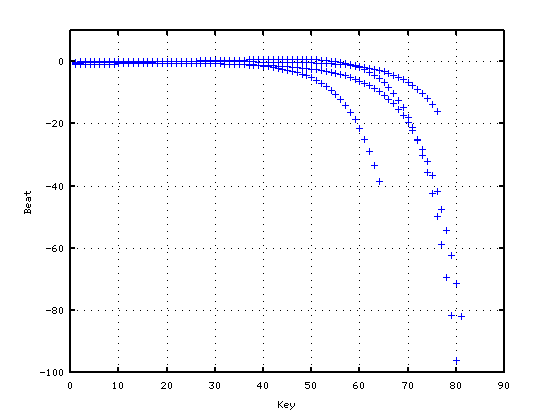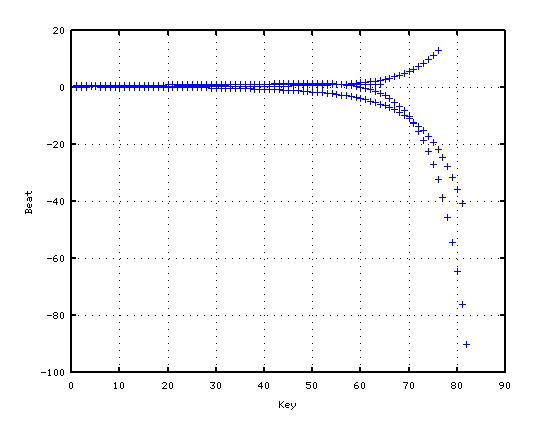インハーモニシティのある場合の“うなり”です。
まず 周波数を求めてみます。
function ifreq = getIfrequ(key,leng,bante,multi) inh = getInha(key, leng, bante); icent = calcInha(inh, multi); freq = getFrequ(key)*multi; ifreq = ctof(freq,icent); end
function ih = calcInha(inh,multi) ih = inh*multi.*multi; end
calcInha.mは インハーモニシティ値と倍数から 倍音のインハーモニシティ値を計算します。
> calcInha(0.5, [1 2 3]) ans = 0.50000 2.00000 4.50000
getIfrequ.mは キー番号,弦長,番手,倍数から倍音の周波数を求めます。
> getIfrequ(37, 742.45, 16.5, [1 2 3]) ans = 220.03 440.21 660.70
キー番号とキー間隔,弦長,番手から“うなり”を求めてみます。
function beat = getIbeat(key,inte,leng1,bante1,leng2,bante2) ratio = Interval(inte); freq1 = getIfrequ(key, leng1, bante1, ratio(2)); freq2 = getIfrequ(key+inte, leng2, bante2, ratio(3)); beat = freq2-freq1; end
> getIbeat(37, 5, 742.45, 16.5, 581.81, 16.0) ans = 0.65540
次に キー全体の“うなり”を求めてみます。
ただ 弦データからでは計算が繁雑になるので 全てのインハーモニシティ値を設定して行います。
function ih = makeCurve(wound, a49, grade) ks = [1:88]-wound; #(巻線数, ピッチ, 傾き) ih = cosh(grade.*ks); df = a49/ih(49); ih = ih.*df; end
> inh = makeCurve(28, 0.55, 0.087) > semilogy(inh, '@') > grid on

2つを変更します。
function ifreq = getIHfrequ(key, multi, inh) icent = calcInha(inh, multi); freq = getFrequ(key)*multi; ifreq = ctof(freq, icent); end
function beat = getIHbeat(key, ratio, inha) key2 = key+ratio(1); freq1 = getIHfrequ(key, ratio(2), inha(key)); freq2 = getIHfrequ(key2, ratio(3), inha(key2)); beat = freq2-freq1; end
では シミュレーションしたインハーモニシティ値から キー全体の“うなり”を求めてみます。
function dispIbeats(intes)
inha = makeCurve(28, 0.55, 0.087);
for inte = intes
ratio = Interval(inte);
ks = 1:88-inte;
beat = getIHbeat(ks, ratio, inha);
plot(beat, '@')
hold on
end
hold off
xlabel('Key')
ylabel('Beat')
end
> dispIbeats([5 7 12 24]) > grid on > axis([0 90 -100 10])

4度(5)・5度(7)・オクターブ(12)・2オクターブ(24)の“うなり”です。
しかしまだ Tuningのシミュレーションは行っていません。
そこで Tuningを行ってから キー全体の“うなり”を求めてみます。
function dispTune(intes)
global Inha Cent KB;
KB = 88;
grade = 0.087;
Inha = makeCurve(28, 0.55, grade);
Cent = tuning_c(Inha, 1.0, grade);
for inte = intes
ratio = Interval(inte);
ks = 1:KB-inte;
beat = getIBeat(ks, ratio);
plot(beat,'@')
hold on
end
hold off
xlabel('Key')
ylabel('Beat')
end
function beat = getIBeat(key, ratio) freq1 = getIFrequ(key, ratio(2)); freq2 = getIFrequ(key.+ratio(1), ratio(3)); beat = freq2-freq1; end
function ifreq = getIFrequ(key, multi) global Inha Cent; icent = calcInha(Inha(key), multi)+Cent(key); freq = getFrequ(key)*multi; ifreq = ctof(freq, icent); end
> dispTune([5 7 12 24]) > grid on > axis([0 90 -100 20])

(tuning_c.m は省略)
さらに 画面に説明を加えます。
function dispTune1(intes)
global Inha Cent KB;
KB = 88;
grade = 0.087;
Inha = makeCurve(28,0.55,grade);
Cent = tuning_c(Inha,1.0,grade);
n = 1;
for inte = intes
[ratio name] = Interval(inte);
ks = 1:KB-inte;
beat = getIBeat(ks,ratio);
str = strcat(';', name, ';@', getCP(n++));
plot(beat, str)
hold on
end
hold off
grid on
xlabel('Key')
ylabel('Beat')
axis([0 90 -40 20])
legend(2)
end
> dispTune1([5 7 12 24])
